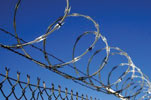

Incarcerating ‘troublesome’ individuals is certainly one way of making society safer and more secure.
However, it also creates environments – ranging from maximum-security correctional institutions to ‘open’ detention centres, each with its own level of risk – which must be controlled, contained and managed.
Modern-day prisons are increasingly run in a business-like fashion. Required to be efficient and effective – especially when it comes to the security and safety of prison personnel, visitors and inmates – these institutions are making ever-greater use of technology.
Identifying and reducing risk
Nowadays, prison should be seen as a community within a community, housing all types of support staff: ranging from prison guards, medical personnel and social workers, to librarians, sports instructors, teachers and catering personnel. Some of the staff never come into contact with the inmates, but others certainly will and special precautions should be taken to safeguard their safety and security.
Occupational hazards and threats from inmates can arise from substance abuse, fanatical ideologies and an unstable mental state, or be caused by overcrowding, gang rivalry and protection rackets. Not only do prison personnel and visitors need to be guarded from the more dangerous inmates, but prisoners also need to be protected from themselves and other inmates.
Bosch approaches prison safety and security from two perspectives: surveillance and personal communication.
Keeping an eye on things
All corridors, internal and external security gates, the external perimeter and specific areas of special risk, such as stairs, lifts and visitor rooms, can be remotely monitored by CCTV. This is most essential for enabling problems to be immediately resolved on the spot before they get out of hand. However, CCTV is not normally used in accommodation facilities, like cells or infirmaries, for privacy reasons. Some prison administrators also prefer not to use CCTV where it could interfere with the personal relationship between staff and prisoners. Of course, exceptions could include cases where constant supervision (for example, in potential suicide, psychiatric, detoxification and drug cases) is needed.
Typically, Bosch CCTV cameras could be installed throughout the prison and connected to monitors at key positions, such as central control where the supervisor would have access to special monitors and control of all cameras.
During an alarm, CCTV images can be automatically sent to the supervisor monitor and recorded. Such recordings (of riots, escapes and disturbances) can be subsequently relayed to the police or other emergency services by means of a special line, or directly (regardless of distance) from the camera-network transmission system.
In prisons where a large number of cameras are installed, those located in areas with low traffic or which are deserted could use the integrated motion-detection system to trigger pictures only when necessary.
CCTV is also useful in gate control, where CCTV cameras with wide-angle lenses (installed at each side of the gates) are deployed in combination with intercom stations. Here, cameras are protected against vandalism by means of a special housing.
CCTV cameras could also offer perimeter surveillance as a backup to the detection system. Additional cameras could be installed on the walls, buildings or masts to cover the inner grounds and prison entrances.
Yet another application is indoor security, where cameras could observe corridor traffic, distinguishing between prison staff and prisoners.
Furthermore, the CCTV cameras can be clustered to observe, for example, corridors, visitors’ rooms, stairs and recreational areas simultaneously, providing the Central Control operator automatic or manual selection of cameras in an emergency.
Good personal communications
The security and safety of personnel also need to be addressed and instant communications – a very fast and adequate response to an emergency to prevent or limit injuries, damage or loss of assets – is what is required.
When an emergency arises, central control at the prison needs to be contacted within a second and provided typically with such vital information as the nature of the alarm and identity and realtime location of the alarm raiser. The problem then needs to be rapidly analysed and classified, and the appropriate pre-defined plan-of-action selected and executed with vital information delivered promptly to the responding officers on the ground. Even if Central Control is unmanned, the system can automatically forward the alarm call to the responding team. Indeed, to take effective action, the time between raising the alarm and responding to it needs to be kept to the absolute minimum.
This is where Bosch’s Personal Security System comes into play. Prison staff at risk can be equipped with a personal security pager to enable them to alert central control manually of an emergency (manual alarm button), or automatically (no-move alarm button or man-down alarm) in case of an incapacitating, personal accident. Thanks to the same device, prison personnel can also receive information about colleagues in need of help.
In addition to personal security devices, the system can also be equipped with Bosch location beacons that will transmit the location where the alarm was raised, together with alarm-call information about the location. If connected to CCTV, the system will also digitally record the alarm situation and provide on-the-scene images to further help assess the kind of assistance needed.
For more information contact Bosch Security Systems, +27 (0)11 651 9818, elaine.o'[email protected], www.boschsecurity.com

© Technews Publishing (Pty) Ltd. | All Rights Reserved.